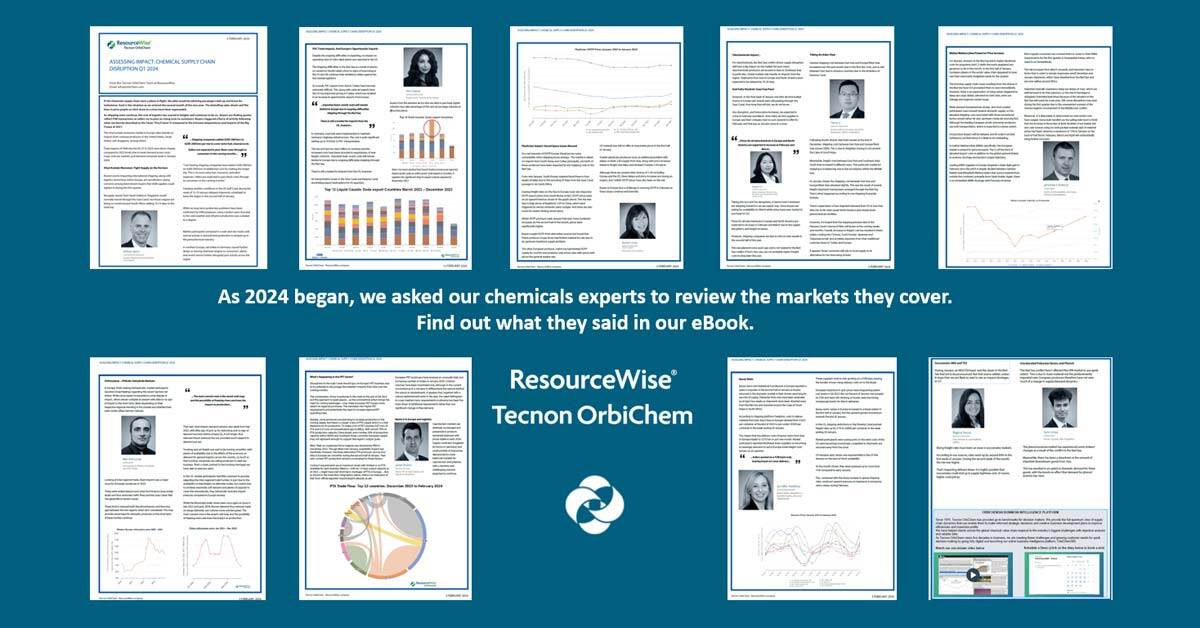4 min read
Feedstock and Chemicals Supply Chains: A 2024 Assessment
 Jane Denny
:
Feb 12, 2024 12:00:00 AM
Jane Denny
:
Feb 12, 2024 12:00:00 AM

A flurry of chemical deals were signed and sealed at the start of the new year. In part, activity was triggered by fear that the US Gulf Coast chill would escalate. But the ongoing issues with Panama Canal crossings and concern over Houthi rebels targeting shipments in the Red Sea played a part too.
For those wondering whether these matters created markets for buyers or sellers, likely, the answer is neither. This latest geopolitical catastrophe—namely dangers to ships on their way to passage through the Suez Canal—is just another unwanted impact factor the chemicals sector must navigate.
Neither upstream producers, converters nor downstream buyers will welcome a near doubling of transportation timeframes, nor their shipments at risk of attack from rebel forces. These factors increase fuel, transit time, and insurance costs, which shipping companies and chemical sellers pass on to consumers.
Shifting Cargo Costs and Impact on Chemical Markets
As fully outlined in the free-to-download eBook, ResourceWise sources quoted additional costs of up to $300/ton to cover longer shipping trips. Another reports a late January US container rate hike of 21% to $6000 due to Panama Canal shipping restrictions.
...Besides a 20% hike in container costs for passage through the Panama Canal, Asian sellers are navigating 200% increases in shipping costs to Europe.
The buyer-pays model appears the only option...
Meanwhile, shipping costs between East Asia and Europe/West Asia soared 200%, according to a China-based ResourceWise chemicals expert. There is evidence that traditional price quotes including the cost of freight have been switched to free on-board (FOB) offers instead. That’s one way to pass on a hike in container costs and one that might even catch a buyer out.

Download a Free Copy of the eBook
...When Russia invaded Ukraine two years ago, insurance premiums skyrocketed. As a result, traders spurned the region even where sanctions were not in force...
As explored extensively in our blog post: Barge Truck or Train: Panama Ships and Supply Chains, tensions in the Middle East are compounding the urgency to reschedule and reroute crude oil supertankers. Not that we haven't been here before. When Russia invaded Ukraine two years ago, insurance premiums skyrocketed. As a result, traders spurned the region even when sanctions were not in force.
Will 2024 Bring Domestic Market Surges?
In some instances, the loss of the shortest route from Asia to Europe has driven customers back to local and regional sources for feedstock and products. Buyers of several products in our chemicals sector intelligence platform OrbiChem360 have tapped more localized markets for supplies.
...High logistics costs for imports from Asia can create exceptional profitability for European and US-produced supply chain products...
After all, high logistics costs for imports from Asia can create exceptional profitability for European and US-produced supply chain products.
That’s certainly the scenario that emerged after Putin invaded Ukraine. As Asian countries battled freight issues and container scarcity, interest in localized feedstocks and resources grew. In markets where the degree of tightness (or unavailability) for each product pivots on import dependency and levels of demand in each region, shipping disruption is a major driver behind supply chain shifts.
Shipping Price Drivers
An oil and energy price reporting agency reports tankers using fast steaming practices. Slow steaming – traveling at 18 knots – saves on costs when fuel oil prices rise. Conversely, tankers diverting around the Cape of Good Hope are sailing above normal speeds—up to 22 knots—to alleviate delivery delays.
The practice will, of course, result in higher fuel costs. Already as a result, according to the report, demand for African marine fuel is increasing.
Other countries to benefit are the US and Brazil. European buyers are turning to the Atlantic Basin Countries for diesel supplies, Brussels-based cargo tracking, and analytics provider Kpler said here.
The South American country, however, is also reported to be harnessing cheap Russian diesel supply off the back of sanctions against Russia, according to another report using Kpler insights and a paywall-protected Financial Times investigation.
Energy, Fuel, Feedstock, and Geopolitical Ripple Effects
With Qatar a major exporter of liquid natural gas worldwide, its decision to divert from the Suez route around the Cape of Good Hope will impact delivery times. As of February, there is still no significant impact on energy prices globally.
However, Saudi Aramco—the Saudi state-owned oil producer in Qatar’s neighboring country—raised its domestic diesel price by over 50% as 2024 began.
Kpler pegged Saudi Arabia as the world's second-biggest exporter of diesel and gasoil in 2023, with output just above that of the US. However, Bloomberg reported that Saudi Arabia has been snapping up diesel supplies from Russia that Europe had sanctioned.
Saudi Aramco also raised ethane prices in January, and there was concern that this ethane price hike would negatively impact chemical markets. Though naphtha is the largest-volume petrochemical feedstock for ethylene used globally, low-priced ethane gives a huge advantage to those few countries that have access to supplies.
Crunching the Numbers...
A major ethylene oxide producer, Saudi Arabia's output is less than that of the US, and of course much less than the world’s biggest producer, China. Still, the country’s downstream producers will not welcome these additional costs to production.
...Aramco’s ethane price was $1.75/mnBtu or $87/ton, so the 43% increase is not so outrageous as on first impression...
Charles Fryer, Senior Advisor, Chemical Sector, ResourceWise/Tecnon OrbiChem founder
As the petrochemical sector began its analysis of the rises, Charles Fryer—who founded the ResourceWise company Tecnon OrbiChem almost half a century ago and advises its team today—considered the impact.
the ResourceWise company Tecnon OrbiChem almost half a century ago and advises its team today—considered the impact.
“Saudi Aramco’s new ethane price—$2.50 per mnBtu—is somewhat lower than the current ethane price in the US,” he explains.
“It is equivalent to $124/ton. Before 1 January 2024, Aramco’s price was $1.75/mnBtu or $87/ton, so the 43% increase in price is not so outrageous as on first impressions," Fryer (pictured right) adds.
...To Explain Ethane Fundamentals
Ethane prices in the US in early February were 18.8 c/gal, equivalent to $2.82/mnBtu, having fallen by 1.8 c/gal from the previous week. The drop was due to weak ethylene demand and increased ethane production from fracking. [Note: 1 gal = 0.0667 mnBtu; 1mnBtu = 14.993 gal]
Meanwhile, in early February’s US natural gas price was $2.05/mnBtu, so the ethane heat value was 13.6 c/gal. This means that the ethane price was 5.2 c/gal higher than its fuel value. Historically, the premium is 10 c/gal to allow for fractionation, transportation, and storage costs.
Mapping a 2024 Endgame
The US Energy Information Administration expects the Brent crude oil price to average $82/barrel this year (which is the price it is registering at today). The agency further predicts that the global supply and demand of petroleum liquids will be relatively balanced.
Regional influences, and weather-related stoppages, for example, may inject volatility into markets as the year progresses—as seen in benzene so far this year. However, shipping-related impacts are likely to be the most significant trend driver.
That's a turn of fortune for an industry that was mulling its position as recently as 2023. In static markets with nearshoring in vogue, shippers were wondering what it might do with its new tankers and ships coming out of shipyards this year. Now we know, they'll be circumventing the Cape of Good Hope unless some serious diplomacy is achieved, and soon.
Request a free copy of the eBook, Assessing Impact: Chemical Supply Chain Disruption Q1 2024.





